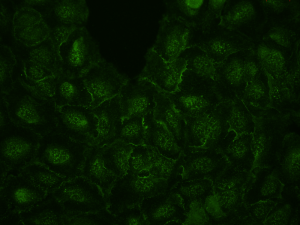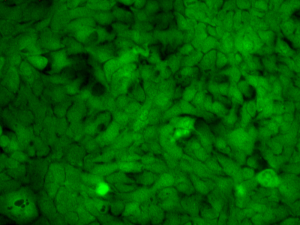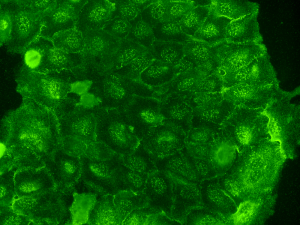Troubleshooting | Immunocytochemistry
Follow our immunocytochemistry troubleshooting guide to quickly identify and get solutions for common protocol issues.
First identify the problem with your immunocytochemistry staining from the options below:
Weak or No Staining
Cells have detached from coverslip:
- Reduce washing steps or wash less vigorously
- Adhere cells to the coverslip using poly-lysine
Cells were not permeabilized:
- Methanol and acetone fixation will permeabilize cells
- If using formaldehyde, permeabilize cells with 0.2% Triton X-100
Cells dried out:
- Samples must be kept covered in liquid throughout the staining process
Cell/tissues are over fixed:
- Reduce the duration of fixation
Not enough primary antibody:
- Use a higher concentration of antibody
- Incubate longer
Incubation time is too short:
- Increase the duration of incubation of the primary antibody with the sample
Slide storage issues:
- Samples should be imaged shortly after processing as the signal decreases over time. Store slides at 4⁰C in the dark if needed.
Primary and secondary antibodies are incompatible:
- The secondary antibody should be raised against the host of the primary antibody. For example, if the primary antibody is a Mouse Anti-HSP70, use an Anti-Mouse secondary antibody (ie. Goat Anti-Mouse).
- Isotypes should also be compatible
Suitability of the primary antibody:
- Confirm that the antibody has been validated in ICC
- Test the antibody in a western blot to make sure it hasn’t been damaged.
Antibody Storage issues:
- Freeze/thaw cycles are detrimental and can cause degradation. It is best to create aliquots of smaller amounts as soon as the product arrives at your location.
- Antibody was not stored as recommended. Unfortunately this might require a new vial to be used instead.
- If the secondary was not stored in the dark (when using immunofluorescence), a new vial will need to be used instead.
Protein is not present in the tissues being tested:
- Run a positive control
- If the protein is present, but not abundantly, use an amplification step to maximize the signal
High Background
Antibody Concentration is too high:
- Dilute the primary and/or secondary antibody further
Non-specific binding:
- Run a secondary antibody control without the primary antibody. If there is staining, then change the secondary antibody, or use a conjugated primary antibody instead
Blocking insufficient:
- Increase the blocking incubation period and consider changing the blocking agent.
Over amplified:
- Reduce amplification incubation time, and dilute the secondary antibody further
Insufficient washing:
- Proper washing of the tissue between steps is critical. Ensure you are following the protocol guidelines for wash steps.
Non-specific Staining
Antibody Concentrations too high:
- Try reducing the concentration, and the incubation period
Primary is raised again the same species as the tissues stained (eg. Mouse on mouse):
- Try using a primary that is raised against a different species. Otherwise try to block the endogenous IgG with serum from the same species as the secondary. You can also try to incubate sections with 1% Triton to clean the tissues. Or use TBS-Tween 20 as a washing buffer, rather than using PBS-Tween 20.
Tried everything from our immunocytochemistry troubleshooting guide and still having trouble? Check out these other useful immunostaining resources:



